INTRODUCTION
Amazonian indigenous peoples inhabit areas of immense biological, linguistic, and cultural diversity (Arias et al. 2018), which means that their reserves represent areas of primary importance for conservation. Indigenous communities play an important role in mitigating the detrimental effects of deforestation throughout their development activities and conservation projects (Alcorn 1993, Zimmerman et al. 2001). For example, agricultural practices by Amazonian indigenous peoples are based on chagra systems, which result from a long process of adaptation, experimentation, and collective innovation (Velez 1998). These agroforestry systems maintain the structure and composition of Amazonian forests based on periods of sustainable use and strategies that have been adapted to characteristics of tropical forests (Acosta Muñoz and Zoria Java 2012).
In Colombia, chagras are developed by indigenous peoples and are areas with temporary crops that remain active for two to five years. The location, size, time of use, and floristic composition of the chagras depend on the characteristics of the land and soil, the type of crop that best suits each habitat, and the requirements and agronomic management of each family group (Triana-Moreno et al. 2006). The establishment of the chagra begins with the cutting of a small area of forest, and after one or two months the vegetation is burned. Later, when the rainy season begins, a wide diversity of transitory and perennial crops is planted, which can be combined following a complex spatial and temporal distribution (Fonseca-Cepeda et al. 2019). Management of chagras is focused on increasing productivity of the various cultivated plants for short periods. Subsequently, the chagra is abandoned, and the following development of these areas represents a similar process to that which occurs in natural succession in forests, extending the sustainability of these agronomic systems through time (Vélez and Vélez 1992). Despite their cultural and food security importance, information about chagras as biodiversity reservoirs is virtually non-existent in Colombia.
Army ants are a monophyletic group within the subfamily Dorylinae, represented in the Neotropics by the genera Cheliomyrmex, Eciton, Labidus, Neivamyrmex and Nomamyrmex (Brady et al. 2014). They are considered one of the most unique life forms found in terrestrial ecosystems within tropical forests as they are the dominant invertebrate predators (Kronauer 2020). This group of ants is characterized by their nomadic behavior, large colony sizes with massive foraging, and by the strong ecological impacts, they exert on communities (Kronauer 2009). For the Neotropical region, 150 species of army ants have been recorded (Bolton c2021), and despite a high variation in their life styles (Rettenmeyer 1963, Kronauer 2020), the foraging habits for some of the most conspicuous species (e.g., Eciton spp.) involve hundreds of thousands of individuals moving hundreds of meters along the ground forests (Couzin and Franks 2003).
We surveyed army ant fauna in different lands use types (forests, chagras in different states of regeneration, and pastures) located in indigenous territories in the Colombian Amazonas to generate baseline information on the biodiversity for these unexplored territories. Specifically, 1) we identified what species of army ants actively forage within different land use types of the indigenous reserve of Santa Sofia, and 2) we contrasted this information with available studies on army ants at a regional (Amazonas department) and national context. With these results as a whole, we expect to provide a more comprehensive assessment of the biodiversity associated with indigenous territories in the Colombian Amazon, and to identify priority areas in Colombia for future myrmecological assessment.
MATERIALS AND METHODS
Study area
Sampling was carried out in the settlement of Santa Sofia near the Tikuna indigenous reserve of the same name. Santa Sofia (04°00'40'' South - 70°08'13" West) is located 35 km northwest of Leticia, capital of the Amazonas department of Colombia (Fig. 1). The region is characterized by its humid and warm climate, with an average annual temperature of 28 °C, average annual precipitation of 3193 mm and average relative humidity of 86 %. The area of the reserve is at an average altitude of 70 m, and it rains approximately 300 days a year (IDEAM c2019).
The region is mainly dominated by non-flooded "Terra Firme" forests, and by várzea forests that can be seasonally found under the water column. In addition, agroecosys-tems are represented primarily by a chagras system, and there is a low representation of savannahs and pastures for livestock (Sanabria 2020). The chagras in the Santa Sofia indigenous reserve are areas of forest which are destined for food security of indigenous families. They comprise an area of approximately 1 ha, which are cut down and burned for cultivation of bananas, plantain, yucca, and some fruit trees. The farms are actively cultivated for an average of five years, and then abandoned for regeneration (Sanabria 2020).
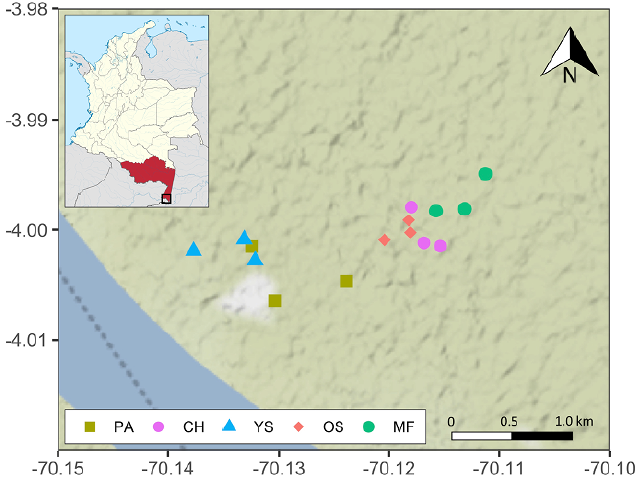
Figure 1 Location of the collection sites indicating the land use types evaluated within the indigenous territory in the reserve of Santa Sofia. PA = Pasture, CH = Active chagra, YF = Shrubland or abandoned chagra between six and fifteen years ago, OS = Secondary forest or abandoned chagra > fifteen years ago, MF = Primary or mature forest.
Sampling of ants
Fieldwork was carried out during the dry season, between 20 June and 10 July 2019. A total of five land use types were sampled (Fig. 2): 1) Primary forests; 2) Secondary forest, or abandoned chagra > fifteen years ago; 3) Shrub-land, or abandoned chagra between six and fifteen years ago; 4) Actively used chagras; and 5) Pastures. Time since the chagras were abandoned was determined from information provided by members of the community who have worked these areas.
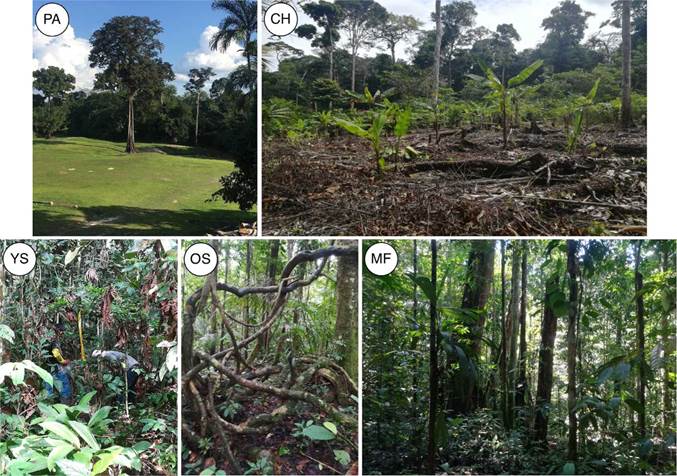
Figure 2 Land use types sampled within the indigenous territory in the reserve of Santa Sofia. PA = Pasture, CH = Active chagra, YF = Shrubland or abandoned chagra between six and fifteen years ago, OS = Secondary forest or abandoned chagra > fifteen years ago, MF = Primary or mature forest.
For each land use, three replications were sampled throughout the indigenous reserve, representing a total of fifteen collection sites (Fig. 1). In each of these sites, linear transects of approximately 100 m were delimited where ten sampling points were arranged; each sampling point was separated by at least 10 m. Pitfall traps were used to estimate the number of army ant species foraging in the different land use types. Pitfall traps consisted of 250 ml plastic cups buried at ground level and filled with approximately 125 ml of 80 % ethanol (half the volume of the cup). Traps were collected after 48 hours. In addition, to increase the efficiency in detecting army ants, one of three replicates for each land use was randomly selected, and a well-established method for evaluation of ant fauna was used: mini-Winkler extractions (Agosti et al. 2000). This method consists of screening 1 m2 of leaf litter, and the resulting soil is hung on a mesh sack that is deposited in the mini-Winkler for 48 h. After this time, all arthropods were collected and preserved in 80 % ethanol. The samples were sorted, all arthropods were separated in different groups and the army ants were subsequently identified to genus and species using the keys by Palacio (2019) and electronic resources available in AntWeb (c2021). A reference collection of material from this study was deposited in the Museo de Entomología de la Universidad del Valle.
Information on army ants in Colombia
In order to contrast the information gathered by our survey with available studies on army ants at a regional (Amazonas department) and national context, we used the most recent and comprehensive compilation of the ant fauna for Colombia (i.e. Hormigas de Colombia by Fernández et al. 2019). We synthesized and summarized all the information related to army ants for each of the country's departments. In addition, we also reviewed worldwide electronic resources for identification and distribution of Formicidae (AntWeb c2021, Bolton c2021) to confirm that new records of army ants for Colombia were included in our results.
Finally, we used R 3.6.3 (R Core Team 2020) with the packages ggplot2 version 3.3.2 (Wickham 2016), ggmap version: 3.0.0 (Kahle and Wickham 2013) and colmaps version: 0.0.0.9515 (Moreno 2015), to calculate the area covered by our sampling and also to produce maps to represent both: sampling points within the indigenous reserve (Fig. 1), and richness of genera and species of army ants in each of the 32 departments of the country.
RESULTS
Across the different land use types in Santa Sofía Indigenous Reserve a total of 187 individual army ant specimens belonging to four genera and eight species were collected (Table 1). By land use, we found that primary forest had the greatest richness with six species, while active chagras and pastures had four species each. In contrast, secondary forest and shrubland had the lowest number of species with two and one respectively (Table 1).
Table 1 Army ant species found in the indigenous reserve of Santa Sofia (Amazonas, Colombia) discriminated by land use type: PA = Pasture; CH = Active chagra; YF = Shrubland or abandoned chagra between six and fifteen years ago; OS = Secondary forest or abandoned chagra > fifteen years ago; MF = Primary or mature forest.
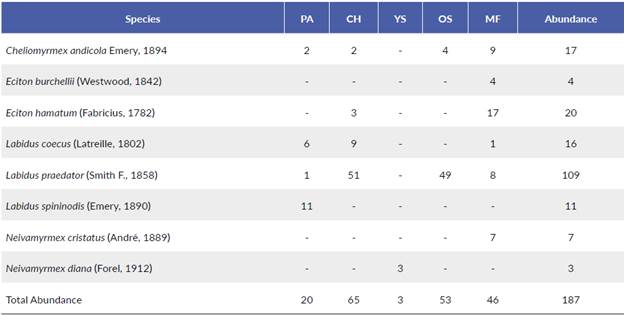
Cheliomyrmex andicola and Labidus praedator were detected in four of the five land use types within the indigenous reserve. Both species were absent from the shrublands (abandoned chagras from six to fifteen years ago). On the other hand, Eciton burchellii, and the two Neivamyrmex species were recorded in only one of the land uses. Shrubland contained only one species: Neiva-myrmex diana (Table 1).
Despite the reduced geographic scale of the sampling area (~15 400 ha), the number of army ants registered for the Santa Sofia indigenous reserve represents 47 % of what is known for this group of ants in the Amazonas department (Table 2), and 18 % for Colombia (Fig. 3). In addition, three new species are registered for the department (E. burchellii, Labidus spininodis, and Neivamyrmex crista-tus) and a new report for the country (N. diana).
Table 2 List of species of army ants recorded in the department of Amazonas (Colombia). Species with asterisk (*) were collected in the Santa Sofia indigenous reserve while other species were reported previously.
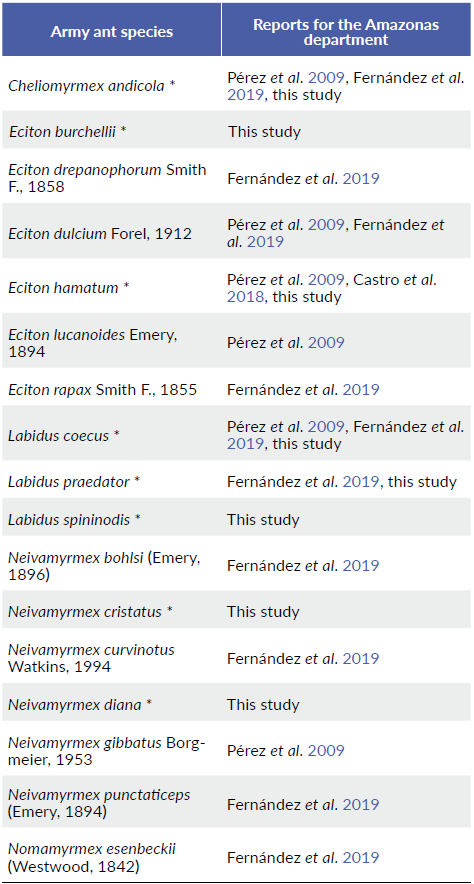
At the country scale, nine departments in Colombia contain all five genera of army ants (Table 3 and Fig. 4a). The department of Amazonas has the second highest diversity of army ants in the country (17), surpassed only by the department of Meta (19). The other departments located in the Amazonian region of Colombia presented a low diversity of army ants (Table 3 and Fig. 4b). Here, we highlight Vaupés, the sixth-largest department in the country and one of the most unexplored without records for this group of ants. Conversely, four departments (Cundinamarca, Valle del Cauca, Nariño and Tolima) showed a high representation of army ants, each one with more than ten species recorded each (Table 3). The departments of Córdoba, Sucre, Norte de Santander, and San Andrés Islas y Providencia do not have records for army ant species.
DISCUSSION
This study is the first biological monitoring project for which the diversity of a group of arthropods, specifically army ants, is evaluated in different land use types from an indigenous reserve in the Colombian Amazonas. These results reinforce the importance of conserving these territories, along with the associated indigenous practices, due to their effectiveness in retaining high diversity of army ants, which have disproportionate ecological importance in neotropical landscapes. Even with limited sampling, this rapid inventory detected close to 20 % of army ant diversity previously recorded for the country and 50 % of the species in the Amazonas department (Fernández et al. 2019, Palacio 2019). We uncovered a new record for Colombia (N. diana) and three new species of army ants are reported for the department. Given the reduced geographic scale of this sampling, and that we did not incorporate a seasonal component, the number of army ants for this area is undoubtedly underestimated here. However, even with these limitations, the importance of these territories for conservation can be inferred given the high number of species detected across different land uses.
For Colombia, a total of 43 species of army ants were previously reported, thirteen of them in the department of Amazonas (Pérez et al. 2009, Castro et al. 2018, Fernández et al. 2019, Palacio 2019). Our sampling brings the number of species to 44 in Colombia and 17 for Amazonas. Neivamyrmex diana has been previously reported in Brazil and French Guyana (AntWeb c2021), and Palacio (2019) proposed that this species could potentially be distributed in Colombian territory. Thus, our report confirms its presence in the country and the distribution of N. diana now extends to the northwestern portion of the Amazonian region, further emphasizing the importance of assessing biodiversity in these indigenous areas.
Table 3 Number of army ant species by genus described for the 32 departments of Colombia (Information compiled based on Fernández et al. 2019, Palacio 2019).
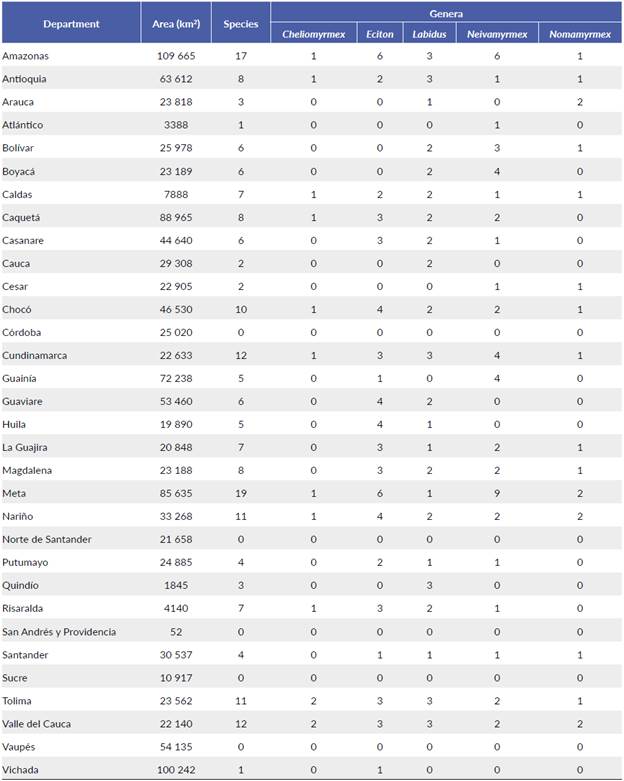
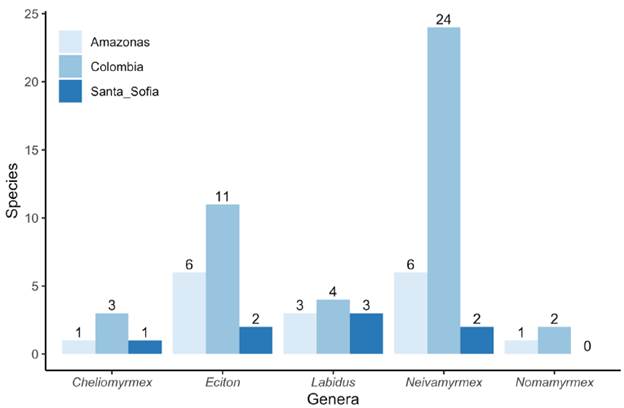
Figure 3 Diversity of genera and species of army ants in the indigenous reserve of Santa Sofia in comparison with the diversity at a departmenta (Amazonas) and national (Colombia) scale.
Previous studies have described the army ant diversity in the Colombian Amazon region. For example, Castro et al. (2018) sampled 71 sites in thirteen municipalities and three departments (Caquetá, Putumayo and Amazonas), covering a wide altitudinal range in the Andean-Amazon transition zone, and reported four species of army ants (C. andicola, Eciton hamatum, L. praedator and Neiva-myrmex cf. hetschkoi). On the other hand, Pérez et al. (2009) reported six species (C. andicola, Eciton dulcium, E. hamatum, Eciton lucanoides, Labidus coecus, and Neivamyrmex gibbatus) while sampling in the vicinity of Leticia using various methods of collection across four years between dry and rainy seasons. Sanabria-Blandón and Achury (2011) captured five species of army ants (C. andicola, E. dulcium, L. coecus, L. praedator, and Neiva-myrmex punctaticeps) from seven land use types in three municipalities in the department of Caquetá (Amazonian foothills). With comparatively lower sampling intensity and number of locations than other studies in the region, our current results revealed the high diversity of ants in the indigenous territory of Santa Sofia, and probably reflect the hyperdiversity in these Amazonian reserves. However, to corroborate this information, monitoring encompassing broader temporal and geographic scales should be a priority for future research.
In the Amazonas department, there are approximately 128 indigenous territories registered as reserves, which together represent an area of 9 358 955.78 ha (Ruiz and Valencia 2007). Indigenous lands act as one of the primary barriers against deforestation and fires produced to expand the agricultural frontier (Nepstad et al. 2006). The communities that inhabit these territories practice a chagras cycle as a sustainable model in the tropical forests where more than 50 plant species are planted (Acosta Muñoz and Zoria Java 2012). These productive systems, therefore, maintain a high biodiversity in the middle of the forest. Our results, although with a reduced scale and restricted to a particular group of ants, support the hypothesis of indigenous reserves and their agricultural production techniques as systems with extremely high diversity. For example, in three transects of mature forest we detected six species of army ants, which represents 35 % of the diversity of the department and 14 % of the country. However, these percentages should be taken with caution since the different genera within the army ants (except Neivamyrmex) present a relatively low number of species, and small changes in richness generate an abrupt change in such percentages. The system of chagras distributed across the reserve retained up to five species. Nevertheless, our sampling does not attempt to generalize how the diversity of army ant changes across the landscape. To understand how species composition changes along different land uses in tropical rain forests (i.e., Beta diversity), an approximation with the totality of ants (Achury and Suarez 2018, Armbrecht et al. 2019) or some more specialized groups such as hunting ants (Sanabria-Blandón and Chacón de Ulloa 2011) is recommended.
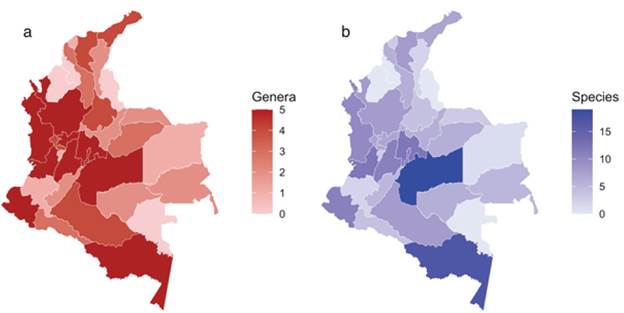
Figure 4 Richness of army ants reported for the 32 departments of Colombia. a. Number of genera and b. number of species.
Colombia is one of the countries in the Neotropical region with one of the greatest diversities of army ants (Palacio 1999). However, this diversity is not uniformly distributed throughout the territory (as seen in Fig. 4). Some departments, particularly those influenced by institutions that conduct intensive ant research (e.g., Amazonas, Valle del Cauca, Cundinamarca), have a relatively high number of species compared to departments that reflect the scarcity of biological collections and monitoring (e.g., Córdoba, Sucre, and Norte de Santander) (Chacón de Ulloa and Abadía 2014, Armbrecht et al. 2019). Certainly, in terms of ant species some areas of the country do not contain as much diversity as the Amazon region or the Chocó biogeographic region; however, we expect that once further exploration is conducted in these areas, we might have a more complete vision of how army ant species are distributed across Colombia. This previous point can be represented with the genus Neivamyrmex. With 126 species described from the Neotropics (Bolton c2021) and 24 for Colombia (Palacio 2019 and current study), this genus is the most diverse and widely distributed of the army ants. Despite this diversity, eleven out of the 32 departments have no records for this genus in spite of seemingly no biological or climatic limitations to assume that they are not distributed in these regions. Neivamyrmex species are subterranean ants and the biology of the vast majority of species is unknown (Borowiec 2016). Focusing on soil sampling or underground pitfall traps will likely increase our knowledge in areas with lack of information in this genus in particular, and army ants in general (Table 3 and Fig. 4).
Our results, along with future research, will not only contribute to increase the knowledge of the ant fauna in these Amazonian landscapes, hopefully will also be used to optimize management and conservation plans. For example, currently pressures such as deforestation for livestock and agricultural purposes using western approaches, which are the main economic activities, are threatening these highly diverse areas and in the future the Colombian amazon basin is projected to experience greater habitat loss and modification due to various energy mining projects planned by the national government (UPME 2017). Indigenous communities need this type of information documenting and quantifying the biological diversity of their territories (e.g., new records for Colombia and Amazonas department), so that they can be considered when executing development plans. We hope this study is the beginning of a more comprehensive effort to document the diversity of ants in indigenous territories and their distribution in these landscapes at the national level.















